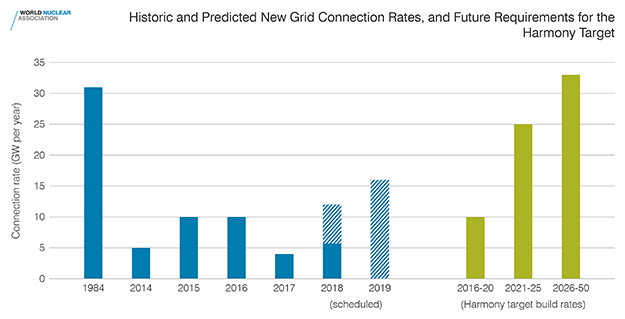Nuclear power generation increased worldwide in 2017 for the fifth successive year according to a report released by the World Nuclear Association (WNA). Production from nuclear plants reached 2,506 TWh in 2017, more than 10% of global electricity demand.
The average capacity factor for the world’s nuclear power plants increased year-over-year to 81.1%, continuing the high-performance displayed over the last two decades, during which average capacity factors have consistently hovered around 80%. In an August 15 press release announcing the publication of “World Nuclear Performance Report 2018,” the WNA noted that reactor performance has been “maintained irrespective of how long a reactor has been in operation.” It said there has been no evidence of “age-related decline.”
There were 59 reactors under construction at the end of 2017. Four reactors were connected to the grid during the year, with an average construction time of 58 months. Four projects were started during the year and two were halted, including two units at the V.C. Summer expansion project in the U.S.
Of the 448 reactors that were operable at the end of 2017, more than half were in the U.S. and Europe. However, reactor retirements continue to outpace capacity additions in both of those regions. New countries, though, are entering the nuclear power club. In Bangladesh, Prime Minister Sheikh Hasina inaugurated the main construction work of the nuclear plant at Rooppur on November 30, 2017. Turkey also formally began construction on its first nuclear unit at the Akkuyu site in December 2017, although actual construction on the reactor did not start until April 2018.
China continues to dominate the new-build market, accounting for three of the four grid connections in 2017, and 18 of the 59 reactors under construction at the start of 2018. The country is also leading the way on two first-of-a-kind reactor projects—the AP1000 and EPR designs. Sanmen 1, an AP1000 unit, and Taishan 1, an EPR unit, both achieved first criticality in June 2018.
Nonetheless, the WNA said build rates would have to increase significantly to achieve its Harmony program target of 1,000 GW of new nuclear capacity by 2050. Harmony is a global vision for the future of electricity. The WNA says to meet the growing demand for reliable, affordable, and clean electricity, the world needs all low-carbon energy sources incorporated as part of a diverse power mix. It envisions nuclear energy capacity expanding to supply 25% of electricity by 2050, which led to its 1,000 GW new-nuclear-capacity goal (Figure 1).
 |
1. Harmony targets. The WNA has set a target of 1,000 GW of new nuclear capacity by 2050. To get there, a significant number of new plants will need to be added. Courtesy: WNA |
“There is no sustainable energy future without nuclear energy. We will need all low-carbon energy sources to work together. Nuclear capacity must expand to achieve the industry’s Harmony goal to enable nuclear energy to supply 25% of the world’s electricity demand by 2050,” Agneta Rising, director general of the WNA, said in the August 15 press release.
—Aaron Larson, executive editor (@AaronL_Power, @POWERmagazine)
The post Nuclear Power Production Up for Fifth Year in a Row appeared first on POWER Magazine.